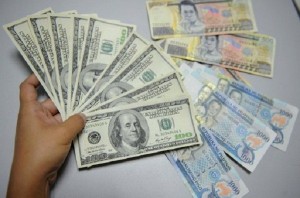MANILA, Philippines—The peso rose minimally on Monday as expectations that the central bank would impose another set of measures to curb currency speculation partially offset the impact of a favorable economic outlook on demand for local securities.
The local currency closed at 41.04 against the US dollar on the first trading day of the week, up by 5 centavos from 41.09:$1 on Friday.
Intraday high hit 41.025:$1, while intraday low settled at 41.05:$1.
Volume of trade amounted to $603.7 million from $729.25 million previously.
Governor Amando Tetangco Jr. of the Bangko Sentral ng Pilipinas was earlier quoted as saying that the monetary authority was prepared to implement other “macro-prudential measures” or bank regulations to temper speculative activities and prevent an even steeper appreciation of the peso.
Earlier this year, the BSP imposed a higher capital requirement for banks’ holdings of non-deliverable forwards (NDFs)—hedging instruments meant for exporters and importers but were believed to be used by some investors and banks for purposes of currency speculation.
The BSP said it has been allowing the exchange rate to be generally market-determined, but it could intervene from time to time to avoid sharp and sudden rise (or fall) of the peso, which it said could happen if speculative activities became rampant. It said excessive volatility of the exchange rate would be bad for business and the economy.
Moreover, BSP Deputy Governor Diwa Guinigundo said macro-prudential measures have been deemed more prudent than interest-rate cuts in addressing the issue of excessive foreign portfolio investments.
The monetary board of the BSP, in its policy-setting meeting last Thursday, decided to keep interest rates steady. But Guinigundo said this did not mean the BSP has not been looking at the issue of capital flows.
According to Guinigundo, the BSP considers the potential surge in foreign portfolio investments as an important issue that deserves regulatory focus.
